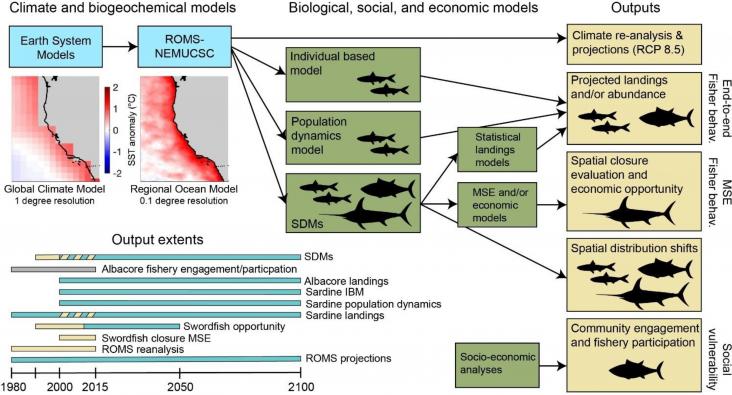
This study shows downscaled climate projections that, without strong curbing of emissions, the California Current System (CCS) will undergo significant change this century, including 2–4 °C warming of sea surface temperature and an almost ubiquitous shift to novel conditions
This paper based on three implemented Regional Climate Models (RCMs), namely CMCC-CCLM, CNRM-ALADIN52, and GUF-CCLM-NEMO, for RCP4.5 and RCP8.5 scenarios of the 21st century. Atmospheric modelling datasets cover the Reference (1971–2000) and Future (2071–2100) Periods of climate projections. The results produced within this study can be used for investigations in specific locations of the Mediterranean basin within integrated hydrologic/hydrodynamic modelling under projected climate change conditions during the 21st century.
This Article supports SDGs3 and 13 by asessing the potential impact of net zero greenhouse gas emissions on public health in England and Wales. The authors showed that there are likely to be substantial net benefits for health, with greater benefits associated with faster and more ambitious changes.
This paper focuses on the impact of epidemic situation on carbon emissions in different provinces of China and provide different emission reduction directions and measures for carbon emission research in different provinces.
Elsevier,
David E. Reichle, Chapter 9 - Ecosystem productivity, Editor(s): David E. Reichle, The Global Carbon Cycle and Climate Change (Second Edition), Elsevier, 2023, Pages 197-232, ISBN 9780443187759, https://doi.org/10.1016/B978-0-443-18775-9.00007-3.
This chapter advances the UN SDG goals 13, 14, and 15 by examining the global distribution of carbon in biomass.
Elsevier,
David E. Reichle, Chapter 10 - The global carbon cycle and the biosphere, Editor(s): David E. Reichle, The Global Carbon Cycle and Climate Change (Second Edition), Elsevier, 2023, Pages 235-283, ISBN 9780443187759, https://doi.org/10.1016/B978-0-443-18775-9.00014-0.
This chapter advances the UN SDG goals 13, 14, and 15 by examining mathematical computer models of biogeochemical processes of atmosphere, land, and oceans can be represente, used to describe the past, present, and future dynamics of the Earth's carbon cycle
Many of the forests of the world are parts of complex landscapes that include intact native forests, forests utilized by communities, and agricultural lands. Understanding ecosystem services at the scale of landscapes benefits from careful consideration of transitions among these land uses, and this article examines these topics for landscapes in Peru and the Philippines.
This chapter advances UN SDG goals 7 and 13 by examining large-scale infrastructure and the associated safety hazards of emerging hydrogen technologies as a replacement for fossil fuels in the global energy and transport industries.
This chapter advances UN SDG goals 7 and 13 by critically evaluating the current status of waste-to-energy (WtE) processes to determine how best to move forward from a few successful WtE demonstrations to commercial-scale processes.
The effects of forest harvesting are very evident aboveground, with clear contrasts between areas that are clearcut and those that are managed with some degree of retention of old trees. The implications for the belowground portions of forest ecosystems are difficult to see, but fundamental to the future development of the recovering forest.
